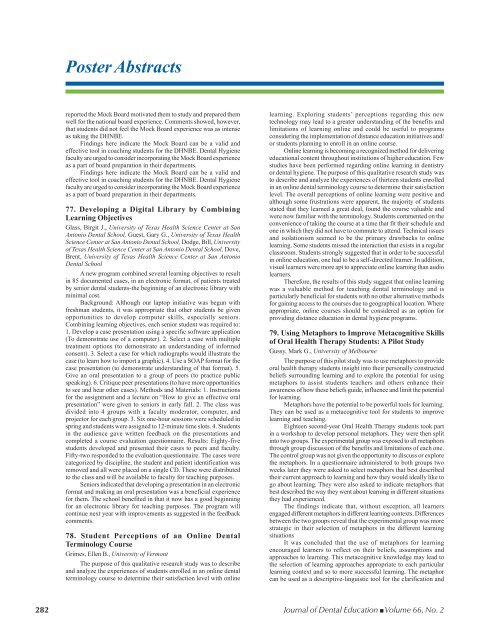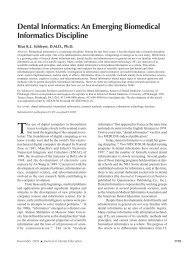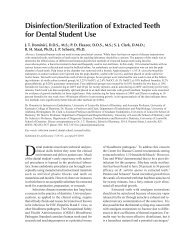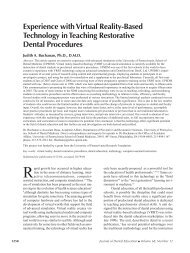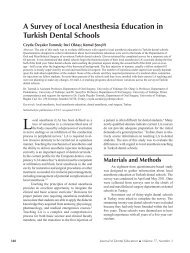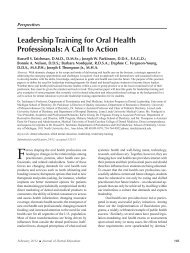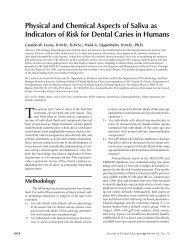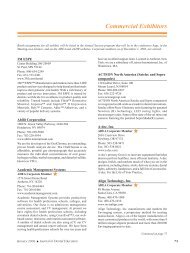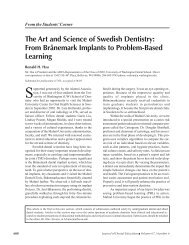List of Poster Presentations - Journal of Dental Education
List of Poster Presentations - Journal of Dental Education
List of Poster Presentations - Journal of Dental Education
Create successful ePaper yourself
Turn your PDF publications into a flip-book with our unique Google optimized e-Paper software.
<strong>Poster</strong> Abstracts<br />
reported the Mock Board motivated them to study and prepared them<br />
well for the national board experience. Comments showed, however,<br />
that students did not feel the Mock Board experience was as intense<br />
as taking the DHNBE.<br />
Findings here indicate the Mock Board can be a valid and<br />
effective tool in coaching students for the DHNBE. <strong>Dental</strong> Hygiene<br />
faculty are urged to consider incorporating the Mock Board experience<br />
as a part <strong>of</strong> board preparation in their departments.<br />
Findings here indicate the Mock Board can be a valid and<br />
effective tool in coaching students for the DHNBE. <strong>Dental</strong> Hygiene<br />
faculty are urged to consider incorporating the Mock Board experience<br />
as a part <strong>of</strong> board preparation in their departments.<br />
77. Developing a Digital Library by Combining<br />
Learning Objectives<br />
Glass, Birgit J., University <strong>of</strong> Texas Health Science Center at San<br />
Antonio <strong>Dental</strong> School, Guest, Gary G., University <strong>of</strong> Texas Health<br />
Science Center at San Antonio <strong>Dental</strong> School, Dodge, Bill, University<br />
<strong>of</strong> Texas Health Science Center at San Antonio <strong>Dental</strong> School, Dove,<br />
Brent, University <strong>of</strong> Texas Health Science Center at San Antonio<br />
<strong>Dental</strong> School<br />
A new program combined several learning objectives to result<br />
in 85 documented cases, in an electronic format, <strong>of</strong> patients treated<br />
by senior dental students-the beginning <strong>of</strong> an electronic library with<br />
minimal cost.<br />
Background: Although our laptop initiative was begun with<br />
freshman students, it was appropriate that other students be given<br />
opportunities to develop computer skills, especially seniors.<br />
Combining learning objectives, each senior student was required to:<br />
1. Develop a case presentation using a specific s<strong>of</strong>tware application<br />
(To demonstrate use <strong>of</strong> a computer). 2. Select a case with multiple<br />
treatment options (to demonstrate an understanding <strong>of</strong> informed<br />
consent). 3. Select a case for which radiographs would illustrate the<br />
case (to learn how to import a graphic). 4. Use a SOAP format for the<br />
case presentation (to demonstrate understanding <strong>of</strong> that format). 5.<br />
Give an oral presentation to a group <strong>of</strong> peers (to practice public<br />
speaking). 6. Critique peer presentations (to have more opportunities<br />
to see and hear other cases). Methods and Materials: 1. Instructions<br />
for the assignment and a lecture on “How to give an effective oral<br />
presentation” were given to seniors in early fall. 2. The class was<br />
divided into 4 groups with a faculty moderator, computer, and<br />
projector for each group. 3. Six one-hour sessions were scheduled in<br />
spring and students were assigned to 12-minute time slots. 4. Students<br />
in the audience gave written feedback on the presentations and<br />
completed a course evaluation questionnaire. Results: Eighty-five<br />
students developed and presented their cases to peers and faculty.<br />
Fifty-two responded to the evaluation questionnaire. The cases were<br />
categorized by discipline, the student and patient identification was<br />
removed and all were placed on a single CD. These were distributed<br />
to the class and will be available to faculty for teaching purposes.<br />
Seniors indicated that developing a presentation in an electronic<br />
format and making an oral presentation was a beneficial experience<br />
for them. The school benefited in that it now has a good beginning<br />
for an electronic library for teaching purposes. The program will<br />
continue next year with improvements as suggested in the feedback<br />
comments.<br />
78. Student Perceptions <strong>of</strong> an Online <strong>Dental</strong><br />
Terminology Course<br />
Grimes, Ellen B., University <strong>of</strong> Vermont<br />
The purpose <strong>of</strong> this qualitative research study was to describe<br />
and analyze the experiences <strong>of</strong> students enrolled in an online dental<br />
terminology course to determine their satisfaction level with online<br />
learning. Exploring students’ perceptions regarding this new<br />
technology may lead to a greater understanding <strong>of</strong> the benefits and<br />
limitations <strong>of</strong> learning online and could be useful to programs<br />
considering the implementation <strong>of</strong> distance education initiatives and/<br />
or students planning to enroll in an online course.<br />
Online learning is becoming a recognized method for delivering<br />
educational content throughout institutions <strong>of</strong> higher education. Few<br />
studies have been performed regarding online learning in dentistry<br />
or dental hygiene. The purpose <strong>of</strong> this qualitative research study was<br />
to describe and analyze the experiences <strong>of</strong> thirteen students enrolled<br />
in an online dental terminology course to determine their satisfaction<br />
level. The overall perceptions <strong>of</strong> online learning were positive and<br />
although some frustrations were apparent, the majority <strong>of</strong> students<br />
stated that they learned a great deal, found the course valuable and<br />
were now familiar with the terminology. Students commented on the<br />
convenience <strong>of</strong> taking the course at a time that fit their schedule and<br />
one in which they did not have to commute to attend. Technical issues<br />
and isolationism seemed to be the primary drawbacks to online<br />
learning. Some students missed the interaction that exists in a regular<br />
classroom. Students strongly suggested that in order to be successful<br />
in online education, one had to be a self-directed learner. In addition,<br />
visual learners were more apt to appreciate online learning than audio<br />
learners.<br />
Therefore, the results <strong>of</strong> this study suggest that online learning<br />
was a valuable method for teaching dental terminology and is<br />
particularly beneficial for students with no other alternative methods<br />
for gaining access to the courses due to geographical location. Where<br />
appropriate, online courses should be considered as an option for<br />
providing distance education in dental hygiene programs.<br />
79. Using Metaphors to Improve Metacognitive Skills<br />
<strong>of</strong> Oral Health Therapy Students: A Pilot Study<br />
Gussy, Mark G., University <strong>of</strong> Melbourne<br />
The purpose <strong>of</strong> this pilot study was to use metaphors to provide<br />
oral health therapy students insight into their personally constructed<br />
beliefs surrounding learning and to explore the potential for using<br />
metaphors to assist students teachers and others enhance their<br />
awareness <strong>of</strong> how these beliefs guide, influence and limit the potential<br />
for learning.<br />
Metaphors have the potential to be powerful tools for learning.<br />
They can be used as a metacognitive tool for students to improve<br />
learning and teaching.<br />
Eighteen second-year Oral Health Therapy students took part<br />
in a workshop to develop personal metaphors. They were then split<br />
into two groups. The experimental group was exposed to all metaphors<br />
through group discussion <strong>of</strong> the benefits and limitations <strong>of</strong> each one.<br />
The control group was not given the opportunity to discuss or explore<br />
the metaphors. In a questionnaire administered to both groups two<br />
weeks later they were asked to select metaphors that best described<br />
their current approach to learning and how they would ideally like to<br />
go about learning. They were also asked to indicate metaphors that<br />
best described the way they went about learning in different situations<br />
they had experienced.<br />
The findings indicate that, without exception, all learners<br />
engaged different metaphors in different learning contexts. Differences<br />
between the two groups reveal that the experimental group was more<br />
strategic in their selection <strong>of</strong> metaphors in the different learning<br />
situations<br />
It was concluded that the use <strong>of</strong> metaphors for learning<br />
encouraged learners to reflect on their beliefs, assumptions and<br />
approaches to learning. This metacognitive knowledge may lead to<br />
the selection <strong>of</strong> learning approaches appropriate to each particular<br />
learning context and so to more successful learning. The metaphor<br />
can be used as a descriptive-linguistic tool for the clarification and<br />
282 <strong>Journal</strong> <strong>of</strong> <strong>Dental</strong> <strong>Education</strong> ■ Volume 66, No. 2


